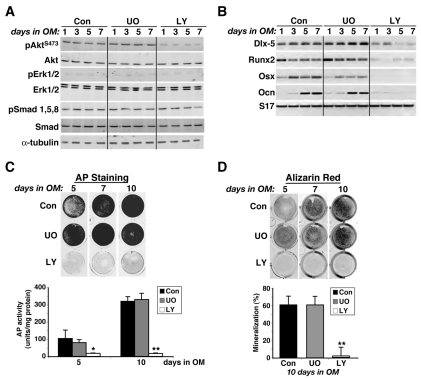Fig. 2.
Inhibition of PI3-kinase activity blocks BMP2-induced osteoblast differentiation. Results are shown of experiments in which C3H10T1/2 cells were incubated in osteogenic media (OM) containing BMP2 for up to 10 days without (Con, control) or with the MEK inhibitor UO126 (UO) (10 μM) or the PI3-kinase inhibitor, LY294002 (LY) (20 μM), as described in the Materials and Methods. (A) Immunoblots of whole-cell protein lysates for Akt phosphorylated at Ser473 (pAktS473), total Akt, tyrosine and serine phosphorylated Erk1 and Erk2 (pErk1/2), total Erks, serine phosphorylated Smad1, Smad5 and Smad8 (pSmad1,5,8), total Smads and α-tubulin. (B) Results of RT-PCR assays showing expression of osteoblast-specific genes encoding Dlx-5, Runx2, osterix (Osx) and osteocalcin (Ocn), and the control gene S17 after incubation for up to 7 days in osteogenic medium with or without UO126 or LY294002. (C) Representative images of qualitative alkaline phosphatase (AP) staining in cells after incubation in osteogenic medium with or without UO126 or LY294002 for 5, 7 or 10 days. The graph depicts measurement of alkaline phosphatase activity in lysates of cells incubated for 5 or 10 days in osteogenic medium with or without UO126 or LY294002 (mean ± s.d., n=3; *P<0.01, **P<0.001 vs cells incubated without LY294002). (D) Measurement of osteoblast-mediated mineralization assessed by Alizarin red staining at days 5, 7 and 10 after incubation in osteogenic medium with or without UO126 or LY294002. The graph shows calculation of mineralized area at day 10 (mean ± s.d., n=5; **P<0.01 vs cells incubated without LY294002).

